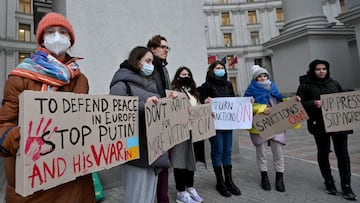SWIFT, the banking system Europe could use to sanction Russia over Ukraine
Stopping Russian access to the SWIFT financial system has been mooted as a sanction that could seriously affect Russia and make it reconsider its invasion

Russia’s invasion of Ukraine has seen sharp increases in the price of oil, and therefore gas, and the fall of stock markets around the world. And while the fall out from the invasion hits economies around the world, it is economic measures that appear to be the main leverage the United States and its allies are considering to make Russian President Vladimir Putin reconsider his bloody strategy of invading Ukraine.
Cut Russia off from SWIFT
One of the sanctions called for by the President of Ukraine Volodymyr Zelenskyy has been to disconnect Russia from the worldwide payment network SWIFT, which stands for Society for World Interbank Financial Telecommunication.
See also:
- Ukraine's Antonov AN-225 'Mriya', the largest plane in the world, destroyed by Russia
- Ukrainian and Russian armies compared
Founded in 1973, and headquartered in Belgium, SWIFT is an interbank messaging service used by thousands of entities worldwide, both financial and non-financial, to send information securely regarding payments that have been carried out. The system underpins financial payments worldwide.
In 2019, more than 11,000 SWIFT members in over 212 countries sent over 33 million transactions a day over the SWIFT network. The original SWIFT organisation was comprised of six major international banks who formed a cooperative society to operate the global network. The SWIFT network is technically the secure messaging system that allows the network to run.
SWIFT provides codes that can identify any institution using the network. Provided someone has that code they can send money to an account held at that precise institution.
The SWIFT code is made up of from 8 to 11 digits:
- A 4 letter bank code
- A 2 letter country code
- A 2 letter location code
- An optional branch code of up to 3 digits
What the SWIFT code does not contain is the bank account number itself, that needs to be supplied separately. The SWIFT or Bank Identifier Code (BIC) just ensures the money gets to the right place, not into the right account.
So if you want to send money from Bank of America in New Jersey to an account at a branch of La Caixa in Madrid, you just need to give the sending bank, Bank of America in this case, the account number and the SWIFT code for that branch, CAIXESBBXX for example. You'd also need the 10 digit account number.
IBANs - International Bank Account Numbers
In addition to SWIFT you may see references to IBANs - these are International Bank Account Numbers, which are not used in the US and Canada, but are common in Europe, so if you've sent money to an EU bank account you'll likely have had to provide an IBAN.
The IBAN has a 2-letter country code, 2 check digits, and up to 35 digits for the bank code, the branch code and the bank account number. It's like having a SWIFT code and the bank account number all in one.
The IBAN format was standardised by the SWIFT network.
Ukraine demands Russia be disconnected from SWIFT
"We demand the disconnection of Russia from SWIFT," said Ukraine's president Zelenskyy in a tweet on Thursday morning, just after the Russian invasion had started.
A package of additional tough sanctions against Russia from the EU is approaching. Discussed all the details with @EmmanuelMacron. We demand the disconnection of Russia from SWIFT, the introduction of a no-fly zone over Ukraine and other effective steps to stop the aggressor.
— Володимир Зеленський (@ZelenskyyUa) February 24, 2022
However as of Friday morning, neither the US or the EU had proposed taking Russia out of the SWIFT system. Faced with the possibility however, Russia has put in place two alternative payment systems, firstly, it's own financial messaging system known as SPFS. The second option, more drastic, is to rely on cryptocurrencies.
Related stories
The expulsion of Russia from the system would likely lead to catastrophic consequences for its economy, as a consequence of its isolation from the international banking system. All types of financial transaction would effectively be blocked, and imports and exports of raw materials, including oil and gas, would be affected.
This would not be the first time that such a measure has been taken. In 2012 and 2018, Iranian banks were booted out of the SWIFT system. In the first instance, due to sanctions from the European Union over the nuclear program, while four years ago economic sanctions put in place by the United States saw Iran kicked out.

